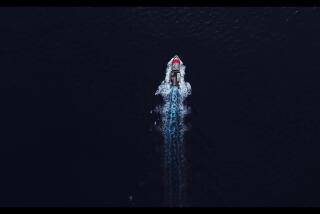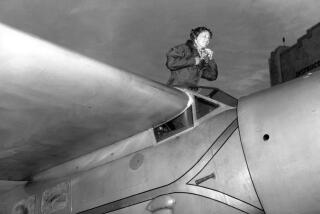Mystery at sea tantalizes searchers
An ambitious, five-day undersea search of Santa Monica Bay for the last missing Womens Airforce Service Pilot from World War II ended Saturday with the whereabouts of Gertrude Tompkins’ P-51D Mustang fighter plane still a mystery.
But divers found the wreckage of two civilian planes -- a light aircraft and a helicopter, they announced Saturday evening. In April, while doing a preliminary search for Tompkins, they discovered an Air Force T-33 jet trainer that had been missing since Oct. 15, 1955.
Tompkins was ferrying the newly built fighter plane from Los Angeles to Newark, N.J., when she disappeared Oct. 26, 1944.
Searchers and members of Tompkins’ family had been hopeful that one of a dozen “tantalizing” targets found on the sea floor off El Segundo might be her aircraft.
Of the wrecks found Saturday, the light aircraft was about a mile offshore and the helicopter about four miles farther, said G. Pat Macha, a member of the search team.
“We hope to identify them next week,” Macha said. “We’ll search again for Gertrude Tompkins. We’re going to use sophisticated magnetometry next time.”
Tompkins’ relatives were disappointed but undaunted.
“I believe she didn’t make the turn when she took off from the airport,” said Laura Whittall-Scherfee, Tompkins’ grandniece. “It’s in the water.”
Whittall-Scherfee, 49, of Carmichael, Calif., was aboard one of the four dive boats that fanned out over a portion of Santa Monica Bay during last week’s search. Divers descended as far as 300 feet, inspecting targets pinpointed by sonar.
Over the years, more than a dozen outings have been organized in search of Tompkins’ missing 32-foot-long Mustang fighter.
Tompkins had taken off with two other WASP-piloted Mustangs headed for Tucson on the first leg of a flight to New Jersey. From there, the Los Angeles-made warplanes were to be shipped to Europe for use in World War II.
A group of about 35 Mustangs had departed at midday, but Tompkins and the other two fliers were delayed until about 4 p.m. by mechanical issues. Her plane’s cockpit canopy had initially failed to close properly.
Tompkins is thought to have made a slow turn toward the south after taking off from what is now Los Angeles International Airport. A 12-year-old boy fishing on the Manhattan Beach pier later reported that through the afternoon haze he had seen a sputtering plane hit the water offshore.
But authorities who had misplaced her flight plan didn’t discover that she was missing for three days.
Tompkins, who was 32, had begun flying in her 20s and later became engaged to her flight instructor. He was killed flying for the British Royal Air Force before they could marry, and Tompkins secretly married her former landlord, Henry Silver, a month before her disappearance. She was listed on military records as Gertrude V. Tompkins.
Whittall-Scherfee said various theories surfaced after Tompkins’ disappearance.
“There were stories that she went to Mexico to run away. There was a myth that she had married a Hollywood producer,” she said.
Macha, a Mission Viejo aviation archaeologist who has written a book about aircraft crashes, served as search facilitator for last week’s ocean hunt. He has theorized that Tompkins may have been unfamiliar with the fuel tank on the then-new model of the Mustang.
When filled, the 85-gallon tank could have shifted the plane’s center of gravity. That could have sent her into a low-altitude dive, Macha said.
Last week’s search, led by Chris Killian of Santa Clarita, involved 16 volunteer divers. They worked from a list of 35 potential crash sites, 12 of which were described as “tantalizing targets.”
The site list was compiled by side-scan sonar user Gene Ralston of Kuna, Idaho, and multibeam sonar expert Gary Fabian of Round Rock, Texas.
Among those taking part in the sea hunt was Robert Hyman, an investor and experienced mountaineer from Washington, D.C. Hyman organized a 2008 search for adventurer Steve Fossett after his disappearance.
“I’m really confident. But I can’t tell you the odds of finding the plane,” Hyman said during the search. “But they’re 0% if you don’t try.”
Relatives of Richard Martin Theiler, the pilot of the T-33 jet trainer, traveled from San Diego to thank the search team for finding his plane. Said his nephew, Richard Miller: “We’re a success story on Gertrude’s behalf.”
--
More to Read
Sign up for Essential California
The most important California stories and recommendations in your inbox every morning.
You may occasionally receive promotional content from the Los Angeles Times.










